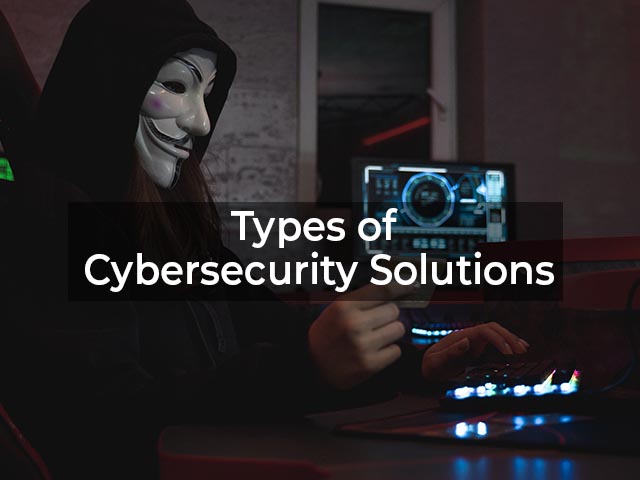Cyber Security can be considered as a broad term, which contributes to protecting an organization, its assets, and its employees from facing any cyber threats. There’s no doubt that data is something very important for any organization, and so is to protect it from any unfortunate attack, or stealing.
As Cyber attacks are becoming more and more common, there need to be some solutions against them, and this is where Cyber security hits back. It has become important to put on layers of security on our systems, so as to protect our data and devices.
In this article, we are going to learn and explore some types of Cyber Security Solutions. We will try to break them down into simple terms, so it becomes easy to understand for everyone.
Types of Cyber Security Solutions
Now, let’s get towards understanding some different types of Cyber Security Solutions. First of all, let’s have a quick list of the types that we are going to discuss, and then we will try to dive deep into the individual topics.
- Network Security
- Cloud Security
- Application Security
- Zero Trust
- Internet of Things Security
- Endpoint Security
- Mobile Security
Now that we have the list of the types that we are going to discuss, let’s try to dive deep into these types.

Network Security
Network Security is again a broader term, which is used in relation to Security over a network. Actually, most of the attacks happen over a network, and the Network Security solutions aim towards and are designed to identify and block these attacks. In short, it focuses more on making your network and computers secure from unauthorized access, data theft, data breaches, etc.
This involves using technologies like Firewalls, Virtual Private Networks(VPNs), and more. Many advanced and multi-layer network security solutions even include Intrusion Prevention Systems (IPS), Next Generation Anti-Virus(NGAV), and more.
Well, over a network, it is very important that we should have some layers of security, which would help us find the potential malicious traffic, and then act accordingly.
Cloud Security
With improving technology, more and more organizations and individuals are turning to cloud-related services. Due to this, it has become important to secure the cloud, and in such a situation, Cloud security comes into the picture.
The cloud security solution includes some solutions and services that can help some organizations and individuals to protect their entire cloud environment from potential attacks.
Cloud is being used by many individuals and organizations all over the world, and this brings in the necessity of Cloud Security since there is a lot of data residing in the cloud, of the individuals and organizations, which needs to be secured.
Application Security
Application Security, or Appsec, can be considered as a broad term, which involves the practice of using hardware and software techniques, best practices, and procedures to make sure that the data or code within the app is not stolen. It involves some security checks that are done during the application design and development process and also involves some systems and some ways to protect the apps post-deployment.
In our everyday life, we tend to use many different applications, that involve granting the use of data to the app, in some form or another, like location, our personal information, and more. While we casually share our data with many apps and services, we should first check if the app is secure or not.
Zero Trust
As the name says, Zero Trust simply requires all the users, whether they are inside the organization, or outside the organization’s network, to be authorized, authenticated, and validated continuously, before they are granted the use of applications and data, or keep their access to use of applications and data.
IoT Security (Internet of Things Security)
Nowadays, many people have been using different IoT devices in their houses and workplaces. It offers a lot of benefits in several areas, while it may invite some Cyber threats. Usually, bad people seek for vulnerable devices connected to the internet, obviously for some bad purposes only, like finding a pathway to enter the corporation, or just to enter the network for something bad.
IoT security aims at protecting IoT devices through many means. There can be a lot of technical things, like auto segmentation to control network activities, using IPS, and more.
Endpoint Security
With Endpoint Security, organizations can easily secure end-user devices like desktops and laptops, with some data and network security controls, with technologies like anti–phishing and anti-ransomware, and more.
Actually, in simple words, we can say that zero trust advises to create micro–segments around the data wherever possible, and one simple way to do that can be considered as Endpoint security.
Mobile Security
This might be ignored by many in this world, but mobile devices, like tablets, and smartphones can also have access to some corporate data, and this may expose businesses to potential threats from some kind of malicious applications in the device, or through phishing, and other types of attacks.
So, using Mobile Security, one can prevent the attacks, and secure the Operating Systems and the devices from jailbreak or rooting. Through using the Mobile Device Management (MDM) solutions, it can be made sure that only authorized or compliant devices have access to corporate data and assets.
What are some common types of Cyber Security Attacks?
Now, let’s have a quick look at some of the common cyber attacks that you should be familiar with so that you can identify the different threats if any, and then act accordingly, or set up safeguards to prevent any of the possible attacks on your system or network.
First of all, here is a quick list including the attacks that we are going to look at, and then we will try to discuss in brief about them one by one.
- Malware
- Phishing
- Spoofing
- IoT Based Attacks.
- Man in the middle attack.
- Denial of Service(DoS) attack.
- SQL Injection.
- Insider Threat
Now, let’s have a look at them in brief, one by one.
Malware
As you also might have heard, Malware is one of the most common types of Cyber attacks. Malware refers to some malicious software viruses, including worms, ransomware, spyware, trojans, and adware.
In short, we can say that the Trojan virus appears to be legitimate software, and is often packaged inside some legitimate software. They are often designed to spy on the victims and to steal data.
Ransomware is designed to block access to the data or the system, and the attacker demands a ransom payment for releasing the data.
Spyware steals your personal and confidential data without your information.
How to prevent Malware from entering into your system?
- Use Antivirus
- Only download trusted applications, from the trusted platforms.
- Use Firewalls.
- Avoid clicking on suspicious links.
- Keep your system updated.
Phishing
Another very widespread and common type of cyber attack is a Phishing attack. This attack is usually carried out through email, and other forms of communication, like text messages, or even websites which may trick the users into downloading some malware or sharing sensitive information and personal and financial information.
In short, it ends up exposing the individual or the organization to some cybercrime. When successful, these attacks often lead to data theft, fraud, ransomware attacks, or huge financial losses.
How to prevent Phishing?
- Never even click on an unknown link.
- Only entertain the emails that you have information about.
- Always check if you are giving away credentials on a legitimate site.
- Always try to scrutinize any email or text message that you feel suspicious.
Spoofing
As the name says it all, Spoofing simply means that someone or something pretends to be something else, and attempts to gain access to our systems or personal information, in order to steal data, or spread malware.
How to prevent Spoofing?
- Turn on spam filtering.
- Scrutinize the email you have received, including the email address, because the email addresses are similar, in order to spoof you.
- Confirm the source of the contact.
- Use password managers for your services, since they won’t work on Spoofed websites.
IoT based Attacks
An IoT-based attack simply means an attack, which targets IoT devices or networks. In short, the IoT devices that give us a lot of convenience may also create multiple access points for hackers to enter the network, and eventually create havoc.
How to prevent IoT-based attacks?
- Disconnect the IoT devices when they are not needed.
- Pick a Strong password and don’t use it anywhere else.
- Change your Router’s default settings.
- Keep the software and firmware updated.
Man in the middle attack
A Man-in-the-middle (MitM) attack involves an attacker between a two-party communication. By doing this, the hackers can steal or manipulate the data. Instead of having the conversation just between the two parties, the communication goes through the hacker.
How to prevent MITM attacks?
- Use encryption on your devices.
- Avoid using the public Wi-Fi.
Denial of Service(DoS) attack
This is one of the attacks, which is a big threat to Organizations. Here, the systems, servers, or networks are targeted by hackers, and they flood it with traffic, to exhaust their resources, which can result in websites slowing down, or shutting down. This makes it overwhelming for the servers to cater to legitimate requests.
You might have also heard about a DDoS attack, which is when attackers are using multiple compromised systems, in order to launch the attack.
How to prevent DoS attacks?
- Periodically check for malicious traffic, and do regular analysis.
- Use DDoS prevention techniques by providers.
SQL Injection
An SQL injection attack may happen on a database-driven website when some hacker tries to manipulate some standard SQL Query. In short, the hacker injects some malicious code into some website search box, making the confidential information visible to the hacker.
This may result in the attacker being able to view, edit, and even delete some tables from the database.
How to prevent SQL Injection?
- Use an Intrusion Prevention System, since it is designed to detect some unauthorized access to the network.
- When the user enters some data into the search box, do some validation on the data.
Insider Threat
As the name says it all, in this type of threat, there would not be some third party, but someone from inside the Organization, who knows everything about the organization. This type of threat can cause tremendous levels of damage.
These types of attacks are more probable in the case of small organizations, since there, the people do have access to a lot of accounts. The reasons why this type of attack might occur is greed, or carelessness by the person who has access to the account. Actually, these types of attacks are hard to predict.
How to Prevent Insider Threats?
- Organizations need to have strict rules and a high ethics level.
- Limiting the IT resources for the staff, giving access according to the job roles.
- Only provide access to those individuals, who are actually trustworthy for the organization.
Other than the above-discussed common Cyber attacks, there are many different cyber attacks that may occur on a small or even large scale. You can even explore more about these and more attacks, and find different ways to prevent them.
Conclusion
In this article, we have seen some of the types of cybersecurity solutions. In this, we have discussed Network Security, Cloud Security, Application Security, Zero Trust, Internet of Things Security, Endpoint Security, and Mobile Security, and we kept examples simple so that it become easy to understand for everyone.
You can explore more and go deeper into these topics, but we have tried to see the overview of some different types of Cyber Security Solutions, and I hope you can learn a lot from this article.
FAQs related to Types of cyber security solutions
Ans: In simple words, you can simply understand a Cyber attack as an attempt to gain unauthorized access to the network, or system, for unethical means. It may result in data theft or even system compromise.
Ans: Cyber security solutions can be considered as measures and techniques that are used to tackle or prevent different types of cyber attacks.
Ans: There are many different types of cyber attacks, and the most common attacks include a Denial of Service (DoS) attack, Malware, Phishing, Man In a middle attack, and more.




